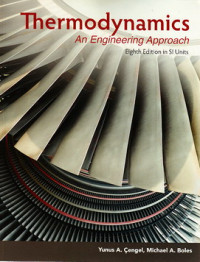Text
Thermodynamics an engineering approach
BACKGROUND
Thermodynamics is an exciting and fascinating subject that deals with energy, and thermodynamics has long been an essential part of engineering curricula all over the world. It has a broad application area ranging from microscopic organisms to common household appliances, transportation vehicles, power generation systems, and even philosophy. This introductory book contains sufficient material for two sequential courses in thermodynamics. Students are assumed to have an adequate background in calculus and physics.
OBJECTIVES
This book is intended for use as a textbook by undergraduate engineering stu¬dents in their sophomore or junior year, and as a reference book for practicing engineers. The objectives of this text are
1. To cover the basic principles of thermodynamics.
2. To present a wealth of real-world engineering examples to give students
a feel for how thermodynamics is applied in engineering practice.
3. To develop an intuitive understanding of thermodynamics by emphasiz¬
ing the physics and physical arguments that underpin the theory.
It is our hope that this book, through its careful explanations of concepts and its use of numerous practical examples and figures, helps students develop the necessary skills to bridge the gap between knowledge and the confidence to properly apply knowledge.
PHILOSOPHY AND GOAL
The philosophy that contributed to the overwhelming popularity of the prior editions of this book has remained unchanged in this edition. Namely, our goal has been to offer an engineering textbook that
1. Communicates directly to the minds of tomorrow's engineers in a
simple yet precise manner.
2. Leads students toward a clear understanding and firm grasp of the basic
principles of thermodynamics.
3. Encourages creative thinking and development of a deeper understand¬
ing and intuitive feel for thermodynamics.
4. Is read by students with interest and enthusiasm rather than being used as an aid to solve problems.
Ketersediaan
Informasi Detail
- Judul Seri
-
-
- No. Panggil
-
536.7 Cen t
- Penerbit
- New York : Mc Graw-Hill., 2015
- Deskripsi Fisik
-
xxvi, 958 hal. : il. ; 26 cm.
- Bahasa
-
English
- ISBN/ISSN
-
9789814595292
- Klasifikasi
-
536.7
- Tipe Isi
-
-
- Tipe Media
-
-
- Tipe Pembawa
-
-
- Edisi
-
Ed. VIII
- Subjek
- Info Detail Spesifik
-
-
- Pernyataan Tanggungjawab
-
-
Versi lain/terkait
Tidak tersedia versi lain
Lampiran Berkas
Komentar
Anda harus masuk sebelum memberikan komentar

 Karya Umum
Karya Umum  Filsafat
Filsafat  Agama
Agama  Ilmu-ilmu Sosial
Ilmu-ilmu Sosial  Bahasa
Bahasa  Ilmu-ilmu Murni
Ilmu-ilmu Murni  Ilmu-ilmu Terapan
Ilmu-ilmu Terapan  Kesenian, Hiburan, dan Olahraga
Kesenian, Hiburan, dan Olahraga  Kesusastraan
Kesusastraan  Geografi dan Sejarah
Geografi dan Sejarah